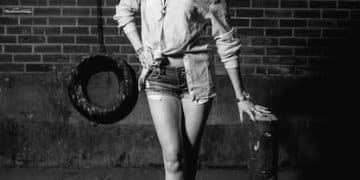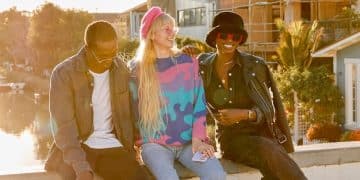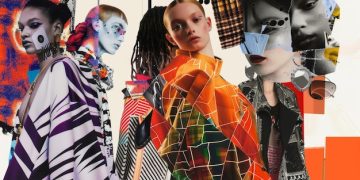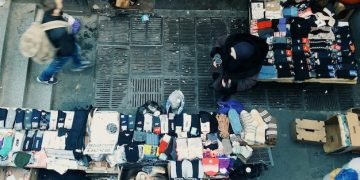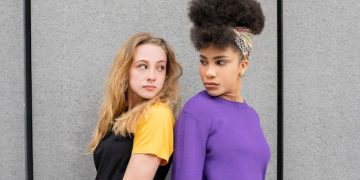Underground Fashion & Music: How Artists Shape Style Trends
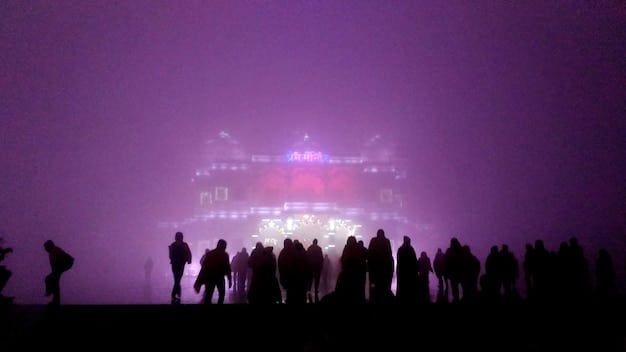
Underground fashion is significantly influenced by the music scene, with artists pioneering unique styles that resonate within subcultures and eventually impact mainstream trends.
The vibrant intersection of underground fashion’s music scene connection: how artists influence style is undeniable. From punk to hip-hop, music subcultures have consistently shaped and redefined what we consider fashionable, expressing unique identities and challenging mainstream norms.
The Symbiotic Relationship Between Music and Fashion
Music and fashion have always been intertwined, each influencing the other in a dynamic exchange of creativity and expression. This is particularly evident in underground scenes, where artists and fans alike use their clothing as a canvas to showcase their individuality and allegiance to specific music genres.
This relationship extends beyond mere aesthetics; it’s a form of communication, a visual language that speaks volumes about identity, beliefs, and cultural affiliations within the underground community.
Early Examples of Music Influencing Fashion
Throughout history, various music movements have catalyzed distinct fashion trends. Consider the rebellious spirit of punk rock, which manifested in ripped clothing, safety pins, and DIY aesthetics, or the flamboyant glam rock scene, characterized by glitter, platform boots, and androgynous styles.
These early examples highlight how music not only inspires fashion but also provides a platform for self-expression and cultural commentary.
- Punk Rock: Torn clothing and safety pins reflected a rejection of mainstream society.
- Glam Rock: Glitter and platform boots embraced androgyny and theatricality.
- Hip-Hop: Baggy clothing and gold chains symbolized status and street credibility.
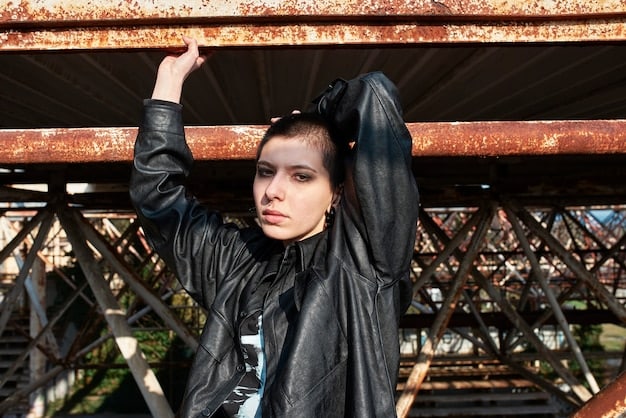
In conclusion, the symbiotic relationship between music and fashion is most visible in underground subcultures, where artists and fans actively promote and embrace unique styles that mirror both personal identity and devotion to their chosen genre.
Defining Underground Fashion: Beyond the Mainstream
Underground fashion is characterized by its departure from mainstream trends, embracing individuality, creativity, and often a DIY ethic. It’s a form of self-expression that thrives outside of commercial influences, allowing for experimentation and the development of unique styles.
Understanding the essence of underground fashion requires recognizing its rebellious spirit and its commitment to authenticity.
Key Elements of Underground Style
Several elements define underground fashion, including its emphasis on vintage and repurposed clothing, its embrace of unconventional materials and techniques, and its rejection of fast fashion in favor of sustainable and ethically sourced garments.
These elements contribute to the unique aesthetic and ethos of the underground fashion scene.
- Vintage and Repurposed Clothing: Promotes sustainability and unique style.
- Unconventional Materials: Explores creativity beyond traditional fabrics.
- Rejection of Fast Fashion: Emphasizes ethical and sustainable choices.
The underground fashion scene often repurposes old clothing or uses otherwise unconventional materials for clothing, helping to both combat wastefulness in the fashion industry and create styles that are truly unique to the artist. These pieces tend to stand out boldly from normal fashion.
How Music Artists Drive Underground Fashion Trends
Music artists play a pivotal role in driving underground fashion trends, serving as tastemakers and trendsetters within their respective scenes. Their personal styles, stage outfits, and music videos often introduce new aesthetics and inspire fans to adopt similar looks.
The influence of music artists extends beyond mere imitation; it fosters a sense of community and belonging among fans who share a common aesthetic.
The Influence of Genre-Specific Styles
Different music genres are associated with distinct fashion styles. For example, the goth subculture is known for its dark, romantic aesthetic, while the rave scene embraces vibrant colors and futuristic designs.
These genre-specific styles provide a framework for self-expression and cultural identity within the underground community.
- Goth: Dark and romantic styles reflect the music’s atmosphere.
- Rave: Vibrant and futuristic designs embody the energy of the scene.
- Grunge: Distressed and casual clothing mirrors the music’s raw sound.
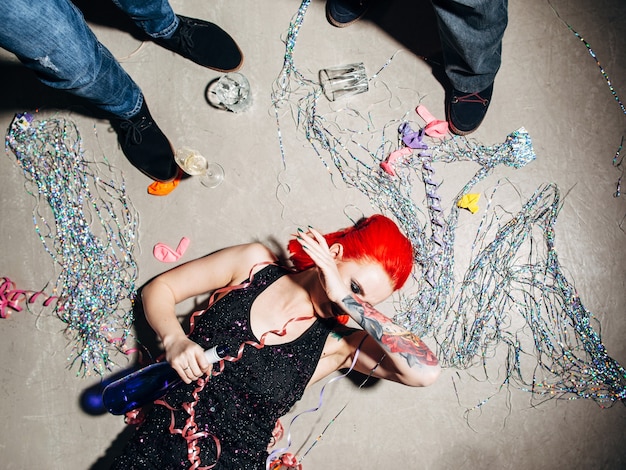
In summation, music artists fuel the circulation of underground fashion, making them influential trendsetters within their own unique musical communities. Much like any other form of expression, they give an identity to the clothing and fashion that fans adopt or adapt.
Notable Artists Who Redefined Fashion Norms
Throughout history, numerous artists have challenged fashion norms and redefined what is considered stylish. From David Bowie’s androgynous glam to Madonna’s provocative pop, these artists have used their clothing as a form of artistic expression and social commentary.
Their influence extends beyond the music industry, inspiring designers and shaping mainstream fashion trends.
Examples of Fashion-Forward Musicians
Several artists have left a lasting impact on fashion, including Jimi Hendrix with his psychedelic rock style, Grace Jones with her avant-garde and gender-bending looks, and Kanye West with his influence on streetwear and high fashion collaborations.
These artists demonstrate the power of music to challenge conventions and redefine beauty standards.
- David Bowie: Pioneered androgynous glam and theatrical costumes.
- Madonna: Provoked through boundary-pushing and iconic looks.
- Jimi Hendrix: Popularized psychedelic rock fashion with bold colors and patterns.
Ultimately, iconic music artists who are fashion-forward serve as significant influencers for each of their respective subcultures. They are typically innovative, expressive, and completely committed to their chosen artistic vision.
The Role of Social Media in Spreading Underground Styles
Social media platforms have played a crucial role in spreading underground fashion trends, providing a space for artists, designers, and fans to connect, share ideas, and showcase their unique styles. Platforms like Instagram, TikTok, and Pinterest have become virtual runways for underground fashion, democratizing access and fostering a global community.
The rise of influencers within the underground fashion scene has further amplified its reach and impact.
Influencers and Online Communities
Numerous influencers and online communities dedicated to underground fashion have emerged on social media, helping to curate styles, promote DIY projects, and connect enthusiasts from around the world. These platforms allow individuals to discover new trends, share their own creations, and participate in discussions about fashion and identity.
The online world has profoundly impacted the accessibility of and inspiration for underground fashion.
- Instagram: Visual platform for showcasing unique underground styles.
- TikTok: Short-form video platform for sharing DIY fashion tips and trends.
- Pinterest: Platform for curating underground fashion inspiration and mood boards.
The accessibility of social media makes these underground communities much more connected and interconnected, making it easier than ever for artists and other figures to reach far beyond their local communities and grow beyond local popularity.
The Future of Underground Fashion’s Music Scene Connection
As technology and culture continue to evolve, the relationship between underground fashion and music is poised to become even more dynamic. The rise of virtual fashion, augmented reality, and personalized style recommendations will likely shape the future of underground fashion in exciting and unpredictable ways.
The ongoing emphasis on sustainability and ethical production will further influence the values and practices of the underground fashion community.
Emerging Trends and Technologies
Several emerging trends and technologies are set to impact the future of underground fashion, including the growing popularity of virtual clothing, the use of AI-powered design tools, and the increasing demand for customized and personalized garments.
These innovations will enable artists and fans to express their individuality in new and innovative ways.
- Virtual Fashion: Opportunities to explore digital identities and creations.
- AI-Powered Design: Tools to foster creativity and innovation in clothing.
- Customization: Tailoring fashion to individual preferences and needs.
The blending of music and fashion scenes will encourage collaborative exploration that emphasizes individuality and is ethically sustainable. As such, underground art could well become a model for the mainstream.
| Key Element | Brief Description |
|---|---|
| 🎸Artist Influence | Artists drive trends through personal style. |
| ♻️Sustainability | Emphasis on vintage and repurposed clothing. |
| 📱Social Media | Platforms spread trends globally. |
| 🚀Future Tech | Virtual fashion and AI design enhancing creativity. |
FAQ
▼
Underground fashion is a style that deviates from popular trends, often characterized by individuality, creativity, and a DIY approach, rejecting commercial influences.
▼
Music artists drive trends through their personal styles, stage apparel, and music videos, influencing fans to embrace similar looks and express community allegiance.
▼
Social media platforms help spread underground fashion trends by enabling artists, designers, and fans to connect, share ideas, and showcase unique styles globally.
▼
Yes, artists like David Bowie, Madonna, and Jimi Hendrix have challenged norms and redefined style through bold looks that reflected both style and values.
▼
Virtual fashion, AI-powered design tools, and personalized garments are expected to play significant roles, enhancing both creativity and personalization, while sustainability will always be critical.
Conclusion
The dynamic relationship between underground fashion and the music scene has fostered unique styles, challenged norms, and created a platform for self-expression. As technology advances, we can expect even greater innovation, personalization, and sustainability within these interconnected worlds, impacting everything from personal identity to what’s considered attractive to the wider world.
